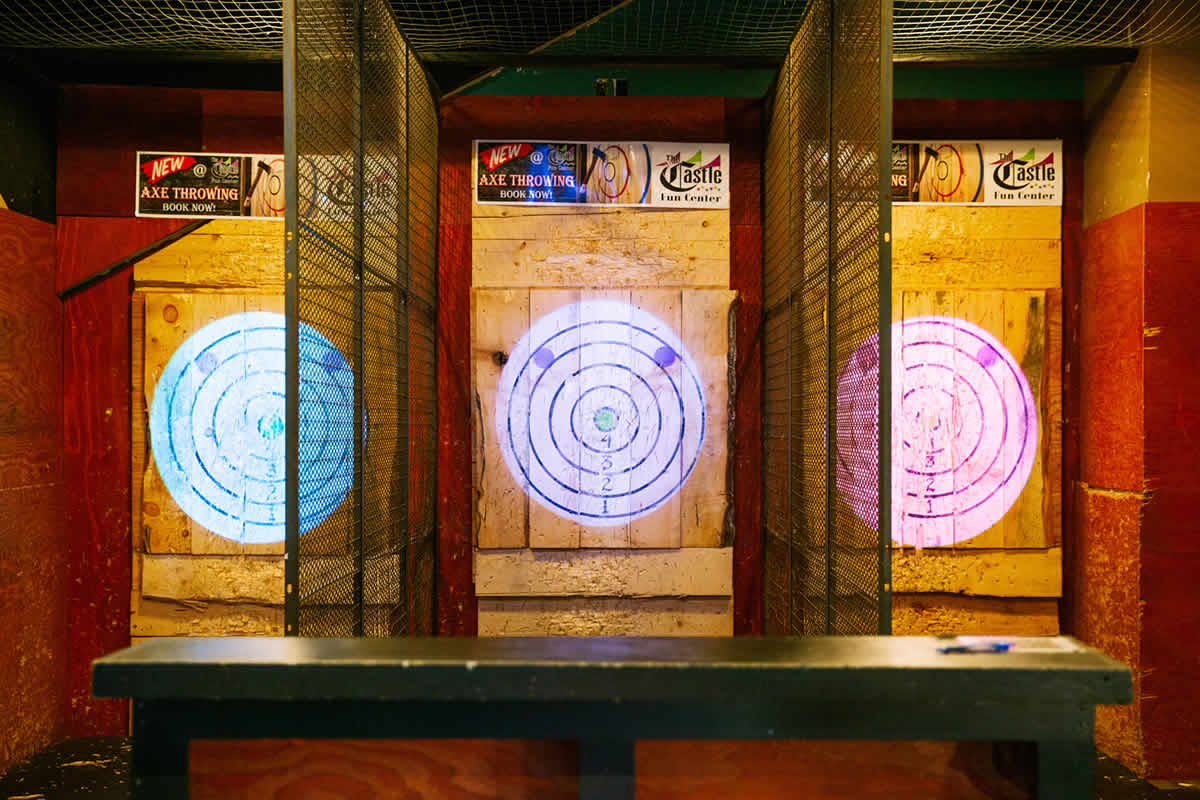Axe Throwing Denver: Remarkable Corporate Occasions and Team Building
Axe Throwing Denver: Remarkable Corporate Occasions and Team Building
Blog Article
The Enjoyable of Axe Throwing: Just How This Sport Incorporates Skill and Adrenaline for a Great Time
Axe throwing has become an astounding sport that masterfully links the requirement for accurate ability with the rush of adrenaline, offering participants a one-of-a-kind and appealing experience. The act of hurling an axe in the direction of a target demands concentration and strategy, at the same time cultivating an ambience of friendship and pleasant rivalry. This appealing blend of mental emphasis and physical effort has actually made axe tossing a prominent choice for those looking for both leisure and a sense of achievement. To genuinely value the depth and allure of this task, one should consider its beginnings, the needed equipment, and the fundamental strategies that make sure both safety and security and satisfaction.
The Origins of Axe Throwing
Axe throwing, a leisure task that has actually gained substantial appeal in current years, traces its origins back to ancient times. The earliest records of axe use in competitive contexts are found amongst the Celts and Vikings, that tossed axes for sporting activity as well as in fight training.
Medieval European warriors, specifically throughout the Middle Ages, exercised axe tossing as part of their martial training. The Francisca, a kind of throwing axe used by the Franks, ended up being legendary for its lethal precision. This standard tool was made to be thrown at opponent guards and armor, showcasing its twin energy in both sport and battle.
In more recent background, axe throwing saw a rebirth in the logging camps of North America in the 20th and 19th centuries. Lumberjacks would engage in friendly competition, examining their precision and stamina by intending at wooden targets. This advancement from a survival skill to a recreational activity has actually led the way for its contemporary revival, with specialized locations and leagues now celebrating the sport around the world.
Tools You Need
Understanding the rich history of axe tossing enhances the appreciation of the sport's modern-day version. Central to this thrilling task is the tools, which is necessary for both safety and security and performance. The main tool is, naturally, the axe. For competitive and recreational axe tossing, one of the most frequently made use of type is the hatchet, normally considering between 1.25 to 2 pounds with a manage size of around 16 inches. The axe should have a sharp, well-maintained blade and a manage made from resilient timber or composite product, making sure an excellent hold and balance.
Just as essential is the target. Regulation targets are created from timber, with softwood selections like want or cottonwood being favored for their capacity to soak up and hold the axe. The target is normally divided right into five concentric circles, each with a particular factor worth, to help with rating.
Security gear, however typically neglected, is critical. Protective gloves can improve grasp and prevent blisters, while closed-toed shoes are a must to protect feet from dropped axes (denver axe throwing). A well-lit, large tossing area, full with security obstacles, guarantees a regulated setting where individuals can concentrate on honing their skills.
Fundamental Techniques Described
Grasping the essential methods of axe throwing is important for both safety and security and effectiveness. The dominant hand should be placed straight below the axe head, while the non-dominant hand sustains the end of the handle.
Your leading foot needs to be a little forward, lining up with your target. This positioning aids in keeping security and routing power properly towards the target.

Security First
Making certain security in axe throwing is paramount to producing a enjoyable and injury-free experience. Safety and security measures begin with the place design. A properly designed axe throwing facility attributes clear demarcations between tossing lanes, tough backgrounds to capture roaming axes, and non-slip floor covering to avoid crashes. In addition, appropriate lights is critical to help participants preserve visual accuracy and spatial recognition.
Benefits of Axe Throwing
Axe throwing deals a myriad of advantages that prolong past easy leisure. Physically, it gives a full-body exercise, involving muscle mass in the arms, shoulders, back, and core. The recurring movement of tossing the axe also improves hand-eye coordination and fine electric motor skills. For those wanting to improve their total fitness, axe throwing can act as a vibrant and appealing form of exercise.
Mentally, axe throwing needs accuracy, emphasis, and technique, making it an excellent means to hone cognitive skills. The concentration required to hit the target can function as a kind of mindfulness, allowing participants to clear their minds and reduce anxiety. This psychological engagement can be especially valuable in assisting individuals create better problem-solving skills and mental resilience.
Socially, axe throwing is frequently appreciated in group settings, cultivating team-building and friendship. Whether as part of a company event or a laid-back getaway with close friends, the sport urges communication and cooperation. Additionally, the public experience of discovering and boosting with each other can strengthen relationships and produce enduring memories.
Final Thought

The earliest records of axe use in affordable contexts are located among the Celts and Vikings, that threw axes for sport as well as in fight training. Launch the axe when your hands are about at eye degree, permitting the axe's all-natural rotation to direct it in the direction of the target.
A well-designed axe throwing facility functions clear separations in between tossing lanes, tough backgrounds to catch stray axes, and non-slip floor covering to protect against accidents. Participants have to be instructed on the proper means to throw the axe and handle, emphasizing managed, purposeful activities over powerful throws.
In recap, axe tossing stands out as a sport that masterfully incorporates skill, adrenaline, and accuracy.
Report this page